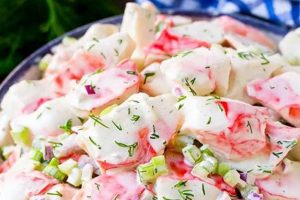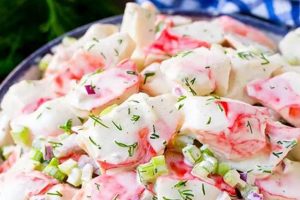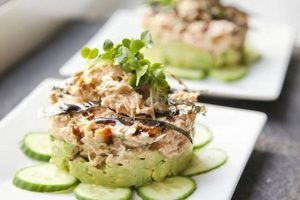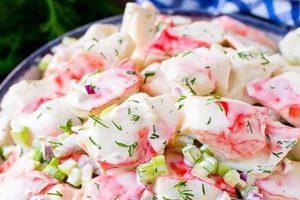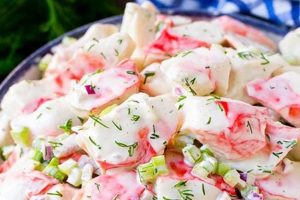Imitation crabmeat, a processed food typically made from surimi (minced white fish), serves as the foundation for a variety of salad preparations. These salads often incorporate mayonnaise, celery, onion, and seasonings, mirroring traditional crab salad in flavor and texture. Variations may include hard-boiled eggs, relish, or other vegetables. A simple example combines imitation crab, mayonnaise, diced celery, and onion, seasoned with salt, pepper, and paprika.
Such salads offer an economical and accessible alternative to dishes using genuine crabmeat. This allows for broader enjoyment of a crab-like flavor profile without the higher cost or potential allergic reactions associated with shellfish. Historically, surimi-based products have roots in East Asian cuisine, later gaining popularity globally as a cost-effective substitute. This affordability contributes to the prevalence of these salads in various settings, from casual lunches to potlucks.
This article will explore various facets of creating these appealing salads, delving into ingredient selection, preparation techniques, and serving suggestions to enhance culinary experiences. From classic recipes to innovative variations, the following sections will offer a comprehensive guide to enjoying these versatile dishes.
Tips for Exceptional Imitation Crab Salad
Elevating imitation crab salad involves attention to detail and thoughtful ingredient selection. The following tips offer guidance for creating a superior culinary experience.
Tip 1: Quality Surimi Selection: Opt for high-quality surimi with a firm texture and a delicate, slightly sweet flavor. Avoid products with an overly fishy odor or a rubbery consistency.
Tip 2: Mayonnaise Matters: The choice of mayonnaise significantly impacts the overall flavor profile. Experiment with different types, such as classic, light, or flavored varieties, to achieve desired results. Aioli or a blend of mayonnaise and plain yogurt can add complexity.
Tip 3: Freshness is Key: Utilize fresh, crisp vegetables. Finely dice celery and onion for optimal texture and flavor distribution. Consider adding finely chopped bell peppers or water chestnuts for added crunch.
Tip 4: Seasoning with Finesse: Avoid over-seasoning. A balanced blend of salt, pepper, paprika, and a hint of Dijon mustard enhances the natural flavors without overpowering them. Old Bay seasoning complements the seafood-inspired profile.
Tip 5: Chill for Optimal Flavor: Allow the salad to chill thoroughly in the refrigerator for at least 30 minutes before serving. Chilling allows the flavors to meld and enhances the overall experience.
Tip 6: Creative Serving Suggestions: Think beyond the traditional sandwich. Serve the salad on lettuce cups, crackers, or as a filling for deviled eggs or tomatoes. Incorporate it into a wrap or use it as a topping for baked potatoes.
Tip 7: Mindful Texture Management: Avoid overmixing the salad, which can break down the surimi and create a mushy texture. Gently fold the ingredients together until just combined.
By adhering to these guidelines, one can transform simple ingredients into a remarkably flavorful and satisfying dish. Careful consideration of each element contributes to a superior culinary outcome.
These tips provide a solid foundation for creating exceptional imitation crab salad. The following section will offer a collection of diverse recipe variations to further inspire culinary creativity.
1. Flavorful Surimi Choice
Surimi selection significantly influences the overall quality and enjoyment of mock crab salad. The nuanced flavor profile of the surimi serves as the foundation upon which other ingredients build, impacting the final taste and texture of the dish. Understanding the characteristics of different surimi options enables informed choices for optimal culinary results.
- Surimi Grades and Quality:
Surimi is available in various grades, impacting flavor, texture, and price. Higher grades generally exhibit a more delicate flavor and firmer texture, resembling real crab more closely. Lower grades might possess a fishier taste or a softer, less desirable consistency. Selecting higher-grade surimi contributes to a more refined and palatable salad.
- Flavor Profiles and Additives:
Different brands and varieties of surimi incorporate various flavorings and additives. Some might emphasize sweetness, while others prioritize a more neutral seafood flavor. Examining ingredient lists allows for alignment with desired taste preferences. For example, those seeking a cleaner flavor profile might opt for surimi with minimal additives.
- Texture Considerations:
Surimi texture ranges from flaky to firm. The desired texture depends on personal preference and intended application. A flakier surimi might blend more seamlessly into the salad, while a firmer variety provides more substantial bite. Considering the overall texture of the salad informs surimi selection.
- Sourcing and Sustainability:
Surimi production utilizes various fish species. Considering the source and sustainability practices of different brands allows for environmentally conscious choices. Supporting sustainable fisheries contributes to responsible seafood consumption.
The careful consideration of surimi grade, flavor profile, texture, and sourcing directly impacts the final product. A discerning choice elevates the overall sensory experience of mock crab salad, transforming it from a simple dish into a culinary delight. By understanding these nuances, one can confidently select the ideal surimi to achieve desired flavor and textural outcomes in their recipes.
2. Complementary Seasonings
Seasoning plays a crucial role in enhancing the flavor profile of mock crab salad, transforming it from a simple combination of ingredients into a well-rounded dish. The right blend of seasonings complements the inherent flavors of the surimi and other components, creating a balanced and enjoyable culinary experience. Careful consideration of seasoning choices allows for customization and elevates the overall sensory experience.
- Balancing Salt and Acidity:
Salt enhances the natural flavors of the ingredients, while acidity provides brightness and complexity. A judicious balance of salt and acidity prevents the salad from tasting bland or overly tart. Lemon juice, vinegar, or a touch of Dijon mustard can contribute the necessary acidity. A pinch of salt amplifies the other flavors without overpowering them. Striking the right balance is key to a well-seasoned salad.
- Enhancing Seafood Notes:
Specific seasonings can enhance the seafood-like character of the surimi. Old Bay seasoning, a blend of celery salt, paprika, black pepper, and other spices, is a classic choice for seafood dishes. A hint of kelp granules or dried dulse flakes can add depth and complexity to the flavor profile, further mimicking the taste of the sea. These specialized seasonings contribute to a more authentic seafood experience.
- Herbaceous Accents:
Fresh herbs introduce bright, aromatic notes to mock crab salad. Finely chopped dill, parsley, or chives complement the other flavors without overpowering them. These herbaceous additions contribute a refreshing element and enhance the overall complexity of the dish. The choice of herbs can be tailored to individual preferences and desired flavor profiles.
- Spice and Heat Integration:
A touch of spice can add depth and intrigue to mock crab salad. A pinch of cayenne pepper or a dash of hot sauce introduces a subtle warmth that complements the other flavors. The level of spice can be adjusted to suit individual preferences, ranging from a gentle warmth to a more pronounced heat. Careful integration of spice prevents it from overpowering the delicate flavors of the salad.
The interplay of these seasoning elements allows for a wide range of flavor profiles in mock crab salad. From classic combinations to more adventurous blends, the thoughtful application of seasonings elevates the dish and contributes to a satisfying culinary experience. The delicate balance of salt, acidity, seafood-inspired spices, herbaceous accents, and optional heat creates a symphony of flavors that enhance the enjoyment of mock crab salad.
3. Textural Balance
Textural balance constitutes a critical element in successful mock crab salad recipes. The interplay of contrasting textures elevates the sensory experience, transforming a simple dish into a more engaging culinary creation. A harmonious blend of textures offers a more satisfying mouthfeel, enhancing enjoyment. This balance prevents monotony and adds depth to each bite.
The inherent softness of surimi benefits from the incorporation of ingredients providing textural contrast. Crisp vegetables, such as finely diced celery, onion, or bell pepper, introduce a refreshing crunch. The addition of chopped water chestnuts or toasted slivered almonds contributes a different type of textural variation. These contrasting elements create a dynamic interplay, preventing the salad from becoming overly smooth or homogenous. For example, a salad relying solely on surimi and mayonnaise might lack textural interest, while the strategic inclusion of crunchy elements adds a welcome dimension.
Achieving textural balance requires careful consideration of ingredient proportions and preparation techniques. Over-mixing the salad can break down the surimi and softer vegetables, resulting in a mushy consistency. Gentle folding ensures the ingredients combine without compromising their individual textures. Additionally, the size and shape of ingredients influence the overall textural experience. Uniformly diced vegetables create a consistent crunch, while larger pieces offer a more pronounced textural variation. Understanding these principles allows for the creation of mock crab salads with a pleasing complexity of textures, enhancing the overall dining experience.
4. Creative Mix-Ins
Creative mix-ins offer an avenue for personalization and flavor exploration within mock crab salad recipes. These additions introduce diverse flavor profiles, textures, and visual appeal, transforming a standard salad into a unique culinary creation. Strategic incorporation of mix-ins allows for customization based on individual preferences and dietary needs.
- Fruits and Vegetables:
Fruits like diced apples, grapes, or mango introduce sweetness and juiciness, complementing the savory notes of the surimi. Avocado adds creaminess and healthy fats. Shredded carrots or chopped jicama contribute vibrant color and textural complexity. These additions expand the flavor profile beyond traditional expectations.
- Nuts and Seeds:
Toasted slivered almonds, chopped walnuts, or sunflower seeds provide satisfying crunch and nutty undertones. These additions introduce healthy fats and proteins, enhancing both the nutritional value and textural interest of the salad. The choice of nuts or seeds influences the overall flavor profile, from subtle nuttiness to more pronounced roasted flavors.
- Herbs and Spices:
Fresh herbs, such as dill, parsley, cilantro, or mint, offer aromatic complexity and freshness. Dried spices like curry powder, cumin, or smoked paprika introduce warmth and depth of flavor. These additions enhance the overall sensory experience, creating a more nuanced and sophisticated salad. The choice of herbs and spices allows for customization based on desired flavor profiles.
- Proteins and Legumes:
Incorporating chickpeas, black beans, or edamame adds protein and fiber, transforming the salad into a more substantial and nutritious meal. These additions also introduce textural variation, creating a more dynamic and satisfying mouthfeel. The choice of protein or legume influences the overall flavor and nutritional composition of the salad.
The judicious selection and combination of these mix-ins unlock a diverse range of flavor profiles and textures in mock crab salad recipes. These additions elevate the dish beyond a simple combination of ingredients, allowing for culinary creativity and personalized flavor experiences. From sweet and savory combinations to spicy and herbaceous blends, the possibilities are vast. The careful integration of mix-ins enhances both the nutritional value and the sensory appeal of mock crab salad.
5. Versatile Presentation
Versatile presentation elevates mock crab salad beyond a simple dish, transforming it into a culinary experience adaptable to various occasions and palates. The method of presentation impacts not only visual appeal but also perceived flavor and enjoyment. Consideration of serving vessels, accompaniments, and garnishes allows for customization and enhances the overall dining experience. This versatility contributes to the enduring popularity of mock crab salad in diverse culinary settings.
Serving options range from classic to contemporary. Traditional presentations include sandwiches, lettuce wraps, and stuffed tomatoes. More innovative approaches incorporate the salad into tartlets, deviled eggs, or as a topping for crostini. These varied presentations influence portion control and perceived elegance. For instance, serving the salad in individual lettuce cups offers a lighter, more refreshing experience compared to a hearty sandwich. Similarly, using endive spears or cucumber rounds as vessels adds a touch of sophistication to a casual gathering. Accompaniments such as crackers, crusty bread, or fresh fruit further enhance the presentation and offer textural contrast.
Garnishes play a crucial role in visual appeal, adding pops of color and texture. Fresh herbs like dill, parsley, or chives provide a vibrant green accent and aromatic complexity. A sprinkle of paprika or a dusting of Old Bay seasoning adds visual interest and reinforces the seafood-inspired flavor profile. Lemon wedges or edible flowers introduce elegance and a touch of brightness. Thoughtful garnishing elevates the presentation from simple to sophisticated, enhancing the overall sensory experience. Understanding these elements allows for tailoring the presentation to specific occasions and preferences, maximizing the enjoyment of mock crab salad.
6. Proper Chilling
Proper chilling is essential for both food safety and optimal flavor development in mock crab salad. Chilling inhibits bacterial growth, mitigating risks associated with mayonnaise-based salads. Additionally, chilling allows the flavors of the various ingredients to meld and intensify, resulting in a more harmonious and enjoyable culinary experience. The temperature and duration of chilling influence the final product. Insufficient chilling can compromise food safety and limit flavor development, while excessive chilling might negatively affect the texture of certain ingredients.
Chilling consolidates the emulsion of mayonnaise-based dressings, preventing separation and maintaining a desirable creamy texture. It also allows the flavors of seasonings and mix-ins to permeate the surimi, creating a more complex and nuanced flavor profile. For example, allowing the salad to chill for at least two hours before serving enhances the subtle sweetness of the surimi while allowing the herbaceous notes of fresh dill or parsley to fully develop. This chilling period also allows the flavors of any added vegetables, such as celery or onion, to mellow and integrate with the other components. Conversely, serving the salad immediately after preparation might result in a less cohesive flavor profile, with individual ingredients tasting somewhat disjointed.
Optimal chilling involves maintaining a consistent refrigerator temperature between 35-40F (2-4C). This temperature range effectively inhibits bacterial growth without freezing the salad. The recommended chilling duration varies depending on the specific recipe and ingredients. Generally, allowing the salad to chill for at least two hours before serving provides ample time for flavor development and ensures food safety. Adhering to these guidelines ensures the optimal balance of safety and flavor, contributing to a satisfying and enjoyable mock crab salad experience. Neglecting proper chilling practices can compromise both the safety and the sensory quality of the dish, diminishing the overall culinary experience.
Frequently Asked Questions
This section addresses common inquiries regarding the preparation and enjoyment of mock crab salad, offering clarity and guidance for culinary enthusiasts.
Question 1: What is the shelf life of prepared mock crab salad?
Properly stored in an airtight container in the refrigerator, mock crab salad typically lasts for 3-5 days. Beyond this timeframe, quality and safety may deteriorate.
Question 2: Can mock crab salad be frozen?
Freezing is not recommended. Freezing negatively affects the texture of the surimi and mayonnaise, resulting in a watery and less palatable salad upon thawing.
Question 3: Is mock crab salad a healthy option?
Nutritional content varies depending on the specific ingredients and preparation methods. Generally, it offers a lower calorie and fat alternative to traditional crab salad, but sodium content can be a concern. Selecting lower-sodium ingredients and incorporating fresh vegetables enhances nutritional value.
Question 4: What are common allergens in mock crab salad?
While not shellfish, surimi is often processed in facilities handling other seafood, posing a risk of cross-contamination for individuals with severe seafood allergies. Additionally, ingredients like mayonnaise contain eggs and soy, which are also common allergens.
Question 5: How can one enhance the flavor of mock crab salad?
Experimenting with seasonings, mix-ins, and serving suggestions allows for flavor customization. Fresh herbs, spices, and citrus elements can elevate the flavor profile. Serving the salad chilled enhances the overall taste experience.
Question 6: Can mock crab salad be served warm?
While traditionally served cold, some recipes incorporate warm components, such as sauteed vegetables or a warm dressing. However, heating the entire salad is generally not recommended as it can negatively affect the texture of the surimi and mayonnaise.
Understanding these aspects facilitates informed choices regarding preparation, storage, and consumption, maximizing enjoyment and minimizing potential risks.
The subsequent sections will offer a collection of diverse recipes and serving suggestions, providing practical applications for the information presented above.
Mock Crab Salad Recipes
Exploration of mock crab salad recipes reveals a versatile and accessible culinary landscape. From foundational elements like surimi selection and complementary seasonings to the integration of creative mix-ins and diverse presentation styles, the potential for customization is vast. Proper chilling techniques underscore both food safety and flavor optimization. Addressing common inquiries regarding shelf life, allergen considerations, and flavor enhancement strategies further empowers culinary endeavors.
The adaptability of mock crab salad recipes allows for creative expression and personalized culinary experiences. Continued exploration of flavor profiles, textures, and presentation methods promises further innovation within this culinary domain. Careful consideration of ingredient selection, preparation techniques, and storage practices ensures both enjoyable and safe consumption of this versatile dish.

